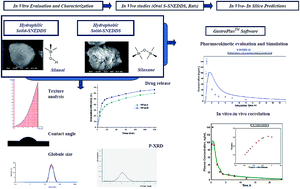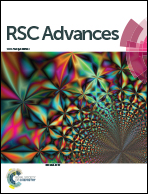Solidified SNEDDS of loratadine: formulation using hydrophilic and hydrophobic grades of Aerosil®, pharmacokinetic evaluations and in vivo–in silico predictions using GastroPlus™†
Abstract
In the present study, hydrophilic and hydrophobic grades of Aerosil® were employed as adsorbents to develop a solid self-nanoemulsifying drug delivery system (S-SNEDDS) of loratadine and were evaluated for their influence on the powder flow, physicochemical and biopharmaceutical properties. Angle of repose measurements revealed better flowability of hydrophilic (15.61°) than hydrophobic (20.03°) S-SNEDDS. Texture analysis assessed their compaction behaviour. Lower initial contact angles were formed on dry hydrophobic S-SNEDDS (19.0°) than the dry hydrophilic one (26.7°). Irrespective of the type of carrier, S-SNEDDS displayed more than 80% drug loading. Hydrophobic S-SNEDDS demonstrated greater drug release (59.33%) at 15 min as compared to hydrophilic S-SNEDDS (48.23%). The excipient-compatibility study indicated no possible interactions. TEM revealed non-aggregated spherical nanosized globules (<50 nm) surrounded by an interfacial surfactant layer. SEM displayed spherical S-SNEDDS having uniform adsorption, and post-release effects depicted the presence of nanometric pores vacated by the previously adsorbed SNEDDS. Pharmacokinetic evaluations displayed enhanced systemic availability and plasma drug concentration attained by hydrophobic S-SNEDDS (Cmax, 185.99 ± 18.99 ng mL−1 and AUC0–t 425.00 ± 17.53 ng h mL−1) compared with the hydrophilic S-SNEDDS (Cmax, 141.45 ± 9.72 ng mL−1 and AUC0–t 353.00 ± 0.01 ng h mL−1). The in vivo–in silico assessment by the GastroPlus software showed good prediction accuracy with the major regional absorption from the upper small intestine. The in vitro–in vivo correlation module presented the best-fit deconvolution model and correlation function for S-SNEDDS. The reconstructed absorption profile was sufficiently superimposable to the observed profiles after convolution. This study indicates the great potential of S-SNEDDS towards enhancement of oral absorption of such poorly soluble drugs, therefore suggesting it could serve as an alternate oral delivery, and presents GastroPlus™ as a efficient tool for in vivo–in silico predictions.


 Please wait while we load your content...
Please wait while we load your content...